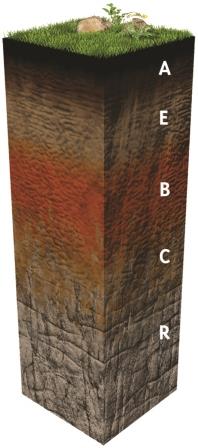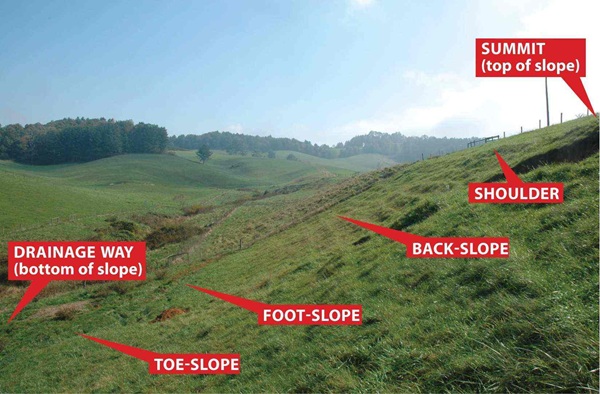What is a Soil Horizon?
Whether you are looking at an excavation, observing an embankment/road cut, or digging a soil pit, you might observe changes in the soil from the top going downwards. The most obvious change to the eye is the difference in color but there is more. The changes often occur in horizontal layers but might also occur diagonally depending on the landscape. A Soil horizon is a wavy horizontal or parallel layer of soil that formed in place as a result of a combination of soil processes. These processes include the addition and removal (loss) of materials, translocation or movement within the soil, and transformation where one component changes into another. (Figure 1)
 Idealized soil profile showing soil horizons
Idealized soil profile showing soil horizonsHow are Soil Horizons identified? Do they have names?
Identification of soil horizons is made from field observations (examination) and is subjected to a set of standard criteria. Usually, samples from each horizon are taken for laboratory analysis to confirm the field observations.
What do Soil Horizons have in Common?
At a minimum, every soil profile has a top layer called the A-horizon and the bedrock layer identified as the C-horizon. Depending on how mature the individual soil is, you can expect to see additional layers in-between the A and C horizons. Another common observation is that, in most cases, the top layer is relatively darker than all other layers. This is due to accumulation of humus -- decomposed plant and animal tissue.
How are Soil Horizons Different?
Soil horizons are different in color, thickness, and/ or how wide each horizon is, the amount of clay fraction present, and they have many unique features that differentiate them. Differences in soil horizons are due to several characteristics. Older soils usually have well developed and a greater number of more layers or horizons than a relatively young soil. Young and old refers to how long ago a particular soil was formed by the five factors responsible for soil: formation
Furthermore, soil horizons are different due to their position on the landscape (Figure 2). The soil on the sideslope of a hill is not so stable compared to the soil that is located down slope or foot slope. This is because of potential for the material upslope to move downslope as a result of gravity and possibly through erosion. Soils formed downslope are more stable and have the ability to weather in place and develop deeper characteristic soil horizons.Soil color is a prominent difference between soil horizons. The colors are due to the presence of different materials in the soil. Organic materials from dead plant tissue and, insect and animal carcasses are often responsible for the dark color in the surface horizon or topsoil. Below the A horizon, colors are typically due to compounds such as oxidized or reduced iron oxides, manganese, presence of sulfates and carbonates, due to poor drainage, or movement of soil components due to the processes mentioned above.

Figure 2. Soils are different as a result of their position on the landscape.
In addition to the above, soil horizons may be different based proportion of sand, silt, clay and stones present in the layer. Clay, being the finest particle size can readily be translocated from upper to a lower horizon. The presence of clay is a dominant diagnostic feature between soil horizons. As mentioned above, chemical compounds in the soil can be dissolved by water and moved from upper horizons to lower ones. Examples of this are aluminum sulfate and calcium carbonates which can make a layer of soil appear bleached relative to the other horizons.
What benefits do these different soil horizons provide?
To start, the A horizon supports plant growth. Food, feed and fiber that animals and humans need for survival are grown in the topsoil or A horizon. Vegetation in all forms also depend on the soil for their life cycle, from grass and landscape plants to giant trees in dense forests.
The various B horizons provide firm support for trees whose roots grow deeper beyond the A horizon thus keeping them established for many generations. The B and C horizons provide the stable base for engineering construction of roads, bridges, tunnels, buildings, including skyscrapers in the cities.
Some B horizons have a type of clay mineral called montmorillonite; a type of expanding clay that is used for sealing ponds and protects the groundwater from water pollution. And, humans have mastered the harvesting of clay from the B horizons to produce clay bricks for home and office construction.
Soil horizons combined to store carbon from the atmosphere, filter runoff water and pollutants and provide many ecosystem services. Together, soil horizons function as parts of an individual soil, which is a three-dimensional natural body. Individual soils together function as part of , that is, a collection of individual soil bodies, to provide ecosystem services for the planet.



